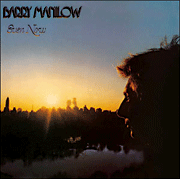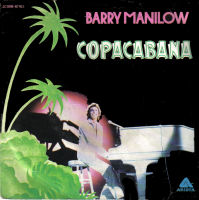In the vast and murky limbo of hipsterdom, Barry Manilow has been both a punch line and a punching bag, a synonym for American pop-music schmaltz. Somehow, though, none of this managed to stop Manilow on his way to armfuls of Grammy, Emmy and Tony Awards and nominations, a still-unbroken run of 25 consecutive Top 40 hits and a place in the Songwriters Hall of Fame. The hits were many and big — “Mandy,” “Even Now,” “Weekend in New England,” “I Write the Songs.” In 1978 alone, five of Manilow’s albums were on the charts simultaneously, a feat in pop music history matched only by Frank Sinatra and Johnny Mathis.
“Copacabana,” recorded in July 1977 for Manilow’s Even Now LP, stands out among the slew of hits. It even won over the Recording Academy that year, garnering Manilow the Best Male Pop Vocal Performance Grammy.
 The song was recorded at A&M Studios in Los Angeles, produced by Manilow and Ron Dante, who brought some of the crew from MediaSound in Manhattan (where he and Manilow had started working together in 1974), which included engineer Michael Delugg and bassist Will Lee. Derek Dunann assisted, recording Lee, drummer Ronald Zito, guitarist Mitch Holder, keyboard player Bill Mays and percussionist Alan Estes. The tracking took place in A&M’s Studio D, in the rear of the building, which at the time was fitted with a 32-input Quad 8 console and monitors comprising Altec 604E speakers in a quad configuration, Vegas subwoofers and Mastering Lab crossovers powered by McIntosh 2100 amplifiers.
The song was recorded at A&M Studios in Los Angeles, produced by Manilow and Ron Dante, who brought some of the crew from MediaSound in Manhattan (where he and Manilow had started working together in 1974), which included engineer Michael Delugg and bassist Will Lee. Derek Dunann assisted, recording Lee, drummer Ronald Zito, guitarist Mitch Holder, keyboard player Bill Mays and percussionist Alan Estes. The tracking took place in A&M’s Studio D, in the rear of the building, which at the time was fitted with a 32-input Quad 8 console and monitors comprising Altec 604E speakers in a quad configuration, Vegas subwoofers and Mastering Lab crossovers powered by McIntosh 2100 amplifiers.
“That room was simply magical — it had the best sound of any room I’ve ever worked in,” recalls Dante. “It had great live echo chambers and it was a fabulous studio to track and do vocals in. We had four other hits that came from those same sessions there, including ‘Can’t Smile Without You.’ Barry and I went back last year to work on a ’70s album and we used the same studio. [A&M is now Henson Studios.] It was very spooky; they had changed out all of the technology, of course, but it still had a lot of that A&M magic in there, 29 years later.”
Manilow had written “Copa” in New York City with co-writers Bruce Sussman and Jack Feldman. He brought a piano-and-voice demo of it to a meeting in Palm Springs with Dante to review material for the album. The producer was skeptical at first of the song. “It sounded very un-Manilow,” he says. “We had been doing big-sounding pop ballads and suddenly here he was with an uptempo, very rhythmic story-song. Then he told me, ‘If this is going to be a hit, then it’s going to be a very big hit,’ and I thought, ‘He’s right. Go for it. Let’s take a chance.’”
Delugg recorded the band bunched tightly together, with little separation between instruments. This was partially out of necessity — he was working on either a Scully or 3M M56 16-track deck (he doesn’t remember which) — and because he believed in the synergy of musicians making eye contact when tracking. “Communication is still the paramount thing between musicians,” he says. “Plus, we didn’t have those 8-track cue mixers back then. I would send the players a basic cue mix through two or three aux sends, and if the drummer needed a little more of something, I’d boost it a bit in one of those. But once they figured out their parts, it was basically a jam session.”
Delugg used relatively few microphones on the basic tracks, but does recall adding a pair of Sennheiser MD-421s on the piano. “That was different from the ballads,” he says. “This was an upbeat song and I wanted to get more attack out of the piano.”
Percussionist Estes came up with the rhythm figure that kicks off the song, and Dante says it was like a beacon for the vibe. “That was such a great band — that with just bass, drums, guitar, keys and percussion, we were able to create a very dense, rhythmic track that really, really cooked,” he recalls.
 Manilow is a master vocalist who was trained in the time-crunched, first-take hotbox of Manhattan’s surging jingle scene in the 1960s and ’70s, where he and Dante, also a jingle singer (and the voice behind The Archies), first met. On Manilow’s records, lead vocal sessions were quick and usually done within a few takes. Dante remembers that “Mandy,” Manilow’s first hit, comprises the pilot vocal from start to finish, with no punch-ins. But with the “Copacabana” track (which Manilow arranged) and the vocal, Dante says there was an implicit understanding that the song shouldn’t get pushed over the edge into out-and-out high camp. “He knew that kind of stuff cold, working with Bette [Midler],” says Dante. (Manilow had been Midler’s musical director since her days performing in the demimonde of Lower Manhattan’s bathhouses and co-produced her first album, The Divine Miss M.) “But we knew this had to stay pop, to not let it get into Gene Kelly-mode, like Bette did with ‘Boogie Woogie Bugle Boy.’ It wasn’t a novelty record. We had to keep it current but with some retro flavor to it. The percussion really made a difference with that. But it could have gone over the edge, easily. It’s still his big closing number live.”
Manilow is a master vocalist who was trained in the time-crunched, first-take hotbox of Manhattan’s surging jingle scene in the 1960s and ’70s, where he and Dante, also a jingle singer (and the voice behind The Archies), first met. On Manilow’s records, lead vocal sessions were quick and usually done within a few takes. Dante remembers that “Mandy,” Manilow’s first hit, comprises the pilot vocal from start to finish, with no punch-ins. But with the “Copacabana” track (which Manilow arranged) and the vocal, Dante says there was an implicit understanding that the song shouldn’t get pushed over the edge into out-and-out high camp. “He knew that kind of stuff cold, working with Bette [Midler],” says Dante. (Manilow had been Midler’s musical director since her days performing in the demimonde of Lower Manhattan’s bathhouses and co-produced her first album, The Divine Miss M.) “But we knew this had to stay pop, to not let it get into Gene Kelly-mode, like Bette did with ‘Boogie Woogie Bugle Boy.’ It wasn’t a novelty record. We had to keep it current but with some retro flavor to it. The percussion really made a difference with that. But it could have gone over the edge, easily. It’s still his big closing number live.”
Manilow sang into a Neumann U87, Delugg’s microphone of choice for him, with little processing — a touch of compression and a slight boost at 5 kHz. “He had this great midrange to his voice where you didn’t have to do a lot to it,” says Dante. Delugg agrees, adding, “Barry knew how to work the microphone when he sang. But one thing I did with him was always set it at exactly the same height every time, which made it easier to match the performance if we had to go back in at a later date to punch something in.”
Still, “Copa” was new territory for Manilow, stylistically speaking. “I wasn’t sure how he was going to approach this song,” says Dante. “But one thing Barry did that made the vocal work was that he put it into the perfect key for a story, where the lyrics have a narrative quality. You can understand every word. To this day, people walk up to Barry or myself, and say, ‘Her name was Lola.’ It’s not the title — it’s the opening line. That’s how good that vocal was.”
Classic Tracks: The Police’s ”Every Breath You Take”
It wasn’t unusual for Manilow to deliver a complete vocal in a single pass, with no punches, usually within the first four or five takes. If a punch was necessary, Delugg would let the singer keep going for another eight to 12 bars rather than pulling up short at the gaffe — a neat psychological trick that kept the vibe positive. Manilow double-tracked the choruses, a process that went even more smoothly. “Once we had a keeper lead vocal, doubling Barry was like icing on a cake; he was that good at it,” says Delugg. The track was sweetened by Butler’s string and horn arrangements, guided by Manilow’s input, and backing vocals from a trio comprising Ginger Blake, Laura Creamer and Linda Dillard.
Delugg remembers the mix of “Copacabana” as typical of the pre-automation era. “We were always low on tracks because Barry and Ronnie used to come up with lots of small ideas to add to the tracks on overdubs,” he says. “I would place things on different tracks wherever I had room, like putting an extra percussion part on the same track as a guitar lick, and I made sure I kept good notes.” In the process, the stereo piano tracks were combined to mono. Delugg and Dante ran the mix down numerous times, rehearsing fader and mute moves. “Copacabana,” like many Manilow mixes, would have a few edits on the final master. “We usually would get 90 percent of it in a single pass, with one or two edits toward the end,” says Delugg.
But the remix was even more interesting. It took place just at the nascent edge of the dance-record and dub-mix era, and Delugg, like other engineers at the time, was feeling his way through it. They brought the multitrack safety back to MediaSound in New York and transferred it to the studio’s newly acquired Studer A-80 24-track deck — getting 50-percent more tracks was like heaven for Delugg. Percussionist Maelin added more rhythms during an all-nighter in Studio A to meet Arista Records president Clive Davis’ request for a version for discos. But the key to the remix was adding groove to the bottom. Delugg accomplished that by pulling out an old Electro-Voice RE38 microphone and having Maelin tap out quarter-notes to create a virtually new bass drum track. “I also hit it with a lot of EQ, boosting it at 50 to 60 Hz, taking out the mids and adding some top end for attack,” Delugg explains.
The “Copacabana” remix had an interesting debut: On a Saturday night that autumn, Dante and Manilow took the dance mix of the song to the real Copacabana club, on East 60th Street on Manhattan’s Upper East Side, where the club had been since 1941. They pulled a favor from the DJ, and at midnight the track was pumped through the nightclub’s speakers.
“Everyone on the floor stopped dancing,” Dante recalls. “I was getting this feeling in my stomach like ‘Uh-oh.’ Then, one couple started dancing and then everyone else jumped in. What a relief. We knew we had nailed it.”







